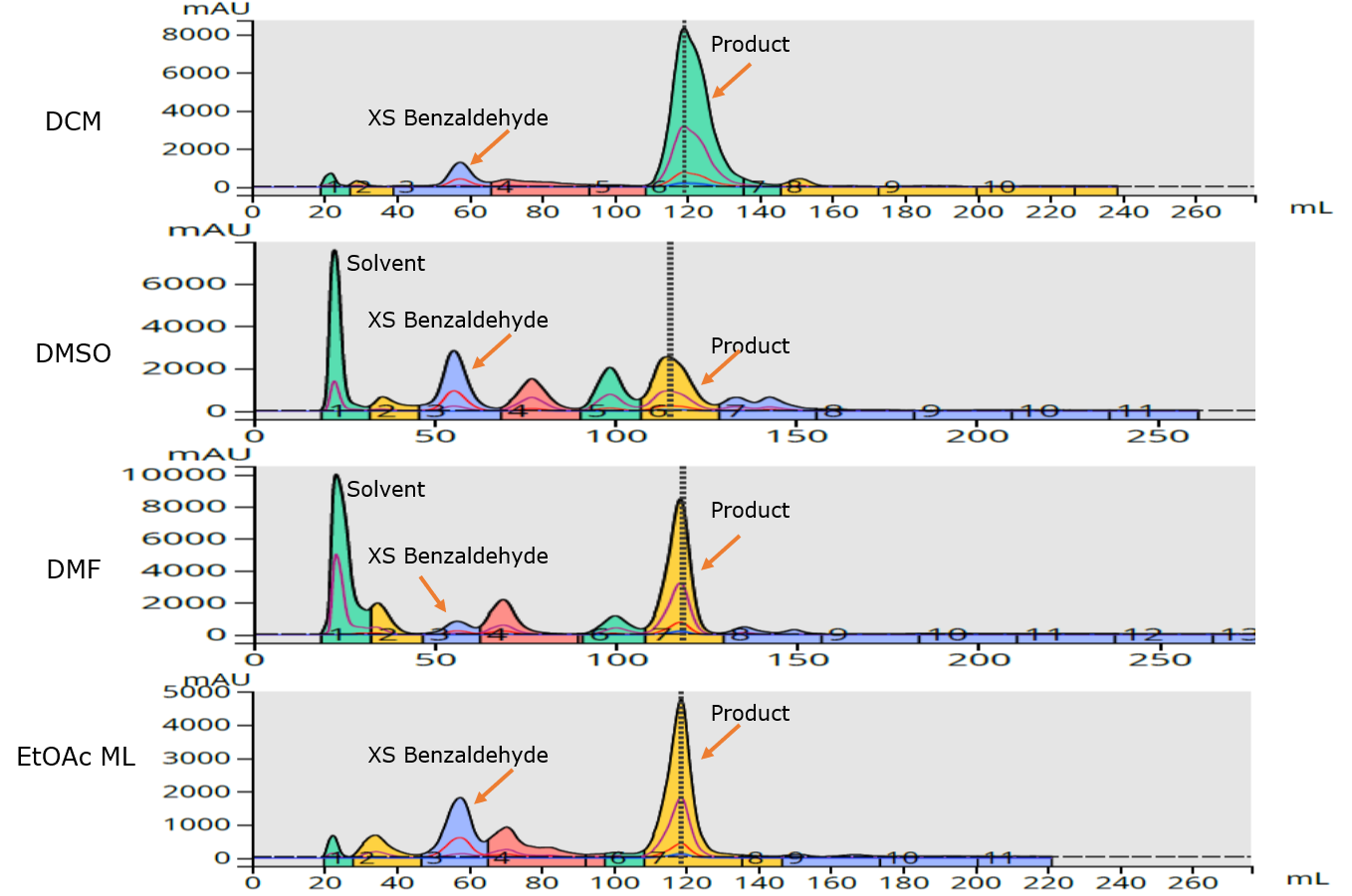Jan 30, 2023 10:59:59 AM
Can reaction solvent choice impact synthesis results?
By Bob Bickler

Most chemical reactions take place in liquid form since compounds in solution are more likely to interact with each other, especially when heated. Reaction solvent choice varies based on reagent solubility and reaction temperature requirements. Because many reactions today require high temperatures, solvents such as dimethylformamide (DMF) and dimethylsulfoxide (DMSO) are frequently used.However, just because a reaction solvent has the proper reagent solubility and/ or a high boiling point does not mean it should be used. Why? Well, as we will show in this post, the solvent itself can alter synthetic efficiency by changing reaction kinetics as well as the number and type of by-products.
This post compares the flash chromatography profiles of the same reaction conducted in four solvents DMF, dichloromethane (DCM), ethyl acetate (EtOAc), and DMSO using microwave-assisted organic synthesis (MAOS).
For the reaction of isatoic anhydride + benzylamine + benzaldehyde + acetic acid, total reagent mass 741 mg, I used a Biotage® Initiator+ at 220 °C [1] for 15 min, Figure 1. While all reagents were fully soluble in DMF and DMSO, isatoic anhydride was marginally soluble in DCM and EtOAc. However, as we all know, heat increases solubility and with a reaction temperature of 150 °C (DCM) / 220 °C (EtOAc), full solubility was achieved and the reaction proceeded.

Figure 1. Synthesis performed for this post. Besides DMF, DMSO, DCM, and EtOAc were used as reaction solvents.
After synthesis, each reactor vial’s contents were transferred to a 20-mL scintillation vial and allowed to cool. Upon cooling, the EtOAc reaction mixture precipitated white crystals indicating the product’s insolubility in the solvent, an ideal situation for a chemist in terms of product purity, but not necessarily yield.
After decanting the EtOAc reaction solution (e.g. mother liquor), the precipitated crystals were washed with 2 x 1 mL of ethyl acetate. The wash solutions were added to the decanted mother liquor for later purification.
Flash chromatography purification was performed using small, 0.1 mL aliquots (~20 mg) of each reaction mixture and the ethyl acetate mother liquor via reversed-phase flash chromatography using a Biotage® Selekt, a 12-gram Biotage® Sfär C18 column, and a 1-gram Biotage® Sfär C18 Samplet cartridge. Samplet cartridges were allowed to air dry to eliminate any chromatographic impact from the lipophilic reaction solvents (DCM, EtOAc) and to provide purification method consistency.
While flash purification showed all syntheses created the desired product, the amount of product and by-products, however, varied greatly, Figure 2.

Figure 2. Flash chromatography comparison of the four reaction mixtures. Both DCM and EtOAc mother liquor purifications show no major closely eluting impurities while the DMSO and DMF reactions generate several.
Collected product fractions from each of the 0.1 mL loads were dried using a Biotage® V-10 Touch evaporation system (HPLC fraction method) into tared vials to determine synthesis yield. With each aliquot representing 20 mg, except for EtOAc mother liquor (10.5 mg after dilution with crystal washes), the yields obtained ranged from 26.5% (DMSO reaction), to 86.5% (DCM reaction), Table 1.
Table 1. Reaction yields based on solvent type
Solvent RxN Conc. (mg/mL) Load (mg) Yield (mg) %Yield
DCM 200 20 17.3 86.5
DMF 200 20 11.8 59.0
DMSO 200 20 5.3 26.5
EtOAc (ppt) 200 N/A 216.6 29.2
EtOAc (m. liquor) 105 10.5 8.2 78.1
So, yes, reaction solvent choice can, and likely will, impact your synthesis success. Based on these experiments, the use of “inert” solvents will provide better synthesis yields. While both DMSO and DMF fully dissolved all of the reaction mixture components, they provided the lowest product yields. Both DCM and EtOAc had limited reagent solubility at room temperature but produced the highest yields and fewer byproducts with similar hydrophobicity.
Interested in learning more? Download our whitepaper – Reducing the Bottleneck in Target Synthesis.
[1] DCM reaction conducted at 150 °C
Published: Jan 30, 2023 10:59:59 AM

